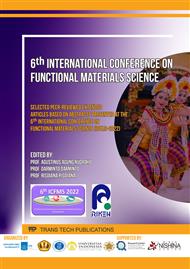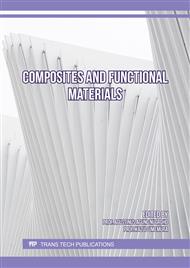p.77
p.83
p.93
p.99
p.105
p.111
p.117
p.123
p.129
Mechanical-Thermal Stability of Micro Composite Based Porous Carbon from Coconut Shell (Cocoa nucifera) Charcoal
Abstract:
Research on the mechanical thermal stability of micro-porous carbon-based micro composites with marine paint matrices has been carried out. Microporous carbon has the property of absorbing radar waves so it is very interesting to research and develop into a microwave shielding material synthesized from coconut shell (cocoa nucifera) by carbonization process at 600°C for 45 minutes. The molecular structure and phases of micro porous carbon were characterized using Fourier Transform Infrared (FTIR) and X-Ray Diffraction (XRD) with the results confirmed of micro carbon with reduced graphene oxide (rGO) phase. Furthermore, micro-composites made from porous micro carbon with marine paint as a binder were made using the wet mixing-casting method. Mechanical thermal testing was carried out by means of a shear test at a temperature range of 30 – 70°C using a Dynamics Mechanical Analysis (DMA) tool. The test results showed that the value of the storage modulus of porous micro carbon composites was 1.653 MPa, 10.196 MPa, 13.068 MPa, 118.567 MPa, respectively. The value of the composite storage modulus increases with increasing concentration of porous micro carbon with an optimum value of mechanical thermal stability at a composition of 70:30 %wt. The results of mechanical thermal testing showed that porous micro carbon with rGO phase from coconut shells has the potential to be used as an anti-radar shielding material. 068 MPa, 118.567 MPa. The value of the composite storage modulus increases with increasing concentration of porous micro carbon with an optimum value of mechanical thermal stability at a composition of 70:30 %wt. The results of mechanical thermal testing showed that porous micro carbon with rGO phase from coconut shells has the potential to be used as an anti-radar shielding material. 068 MPa, 118.567 MPa. The value of the composite storage modulus increases with increasing concentration of porous micro carbon with an optimum value of mechanical thermal stability at a composition of 70:30 %wt. The results of mechanical thermal testing showed that porous micro carbon with rGO phase from coconut shells has the potential to be used as an anti-radar shielding material.
Info:
Periodical:
Pages:
105-110
Citation:
Online since:
July 2023
Authors:
Keywords:
Price:
Сopyright:
© 2023 Trans Tech Publications Ltd. All Rights Reserved
Share:
Citation:



